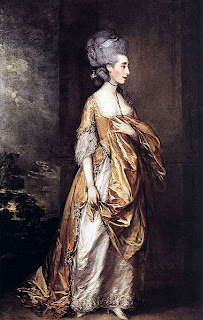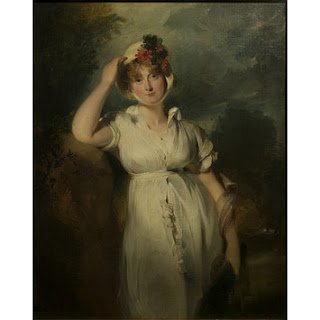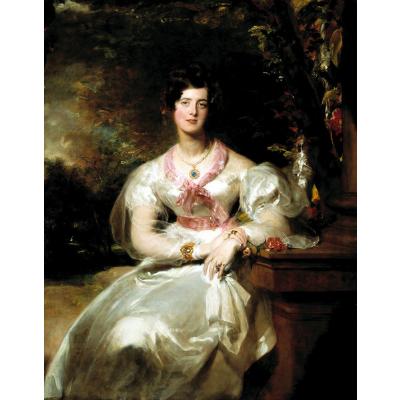
Fashions for females in the Georgian Era changed dramatically, from wide skirts and narrow waists, high-piled coiffures, and fussy decoration to simple, high waisted gowns — and back again in the space of a few decades. Marie Antoinette (1755-1793), Queen of France, right, might have been the most extreme. She was painted in 1778 by Elisabeth Vigee le Brun (1755-1842) in a huge hooped skirt and hair powdered, drawn high and topped off with a fountain of feathers. In an upcoming post, we will look at some of the fashion plates from various lady’s magazines of the Georgian era. In this post, however, we will indulge in the representations of fashion shown in portraits by celebrated artists.
Left is Grace Dalrymple Elliott, subject of Jo Manning’s excellent biography. My Lady Scandalous: The Amazing Life and Outrageous Times of Grace Dalrymple Elliott, Royal Courtesan. She was painted by Gainsborough in the late 1770’s. One of the outstanding features of Gainsborough’s portraits is the depiction of the sumptuous silks and satins worn by his subjects. Again, the hair-do is exaggeratedly high and powdered to a pewter shade rather than the white powdering of a few years earlier. Imagine how many hours had to be spent by these ladies while their minions teased each strand up and over whatever bird-cage-like platform was used.
In the 1780’s and 1790’s, the styles became simpler, perhaps bucolic. Even the French Queen favored a version of the simple muslin chemise. The mode, color and fabric were copied by aristocrats on both sides of the Channel. Hair is more naturally arranged, though still powdered a little, and one could hardly say the hat would be worn by a peasant. Again, the painter is Vigee le Brun.
 |
| Jane Elizabeth, Countess of Oxford, 1797 by John Hoppner Tate Britain |
Gradually the gowns evolved into looser skirts with high waists just below the bosom. The two portraits below by Sir Henry Raeburn(1756-1823) show the exact changes.















I wanted to post you the very little word so as to thank you once again with the fantastic basics you have contributed on this page. It's quite wonderfully generous of you to grant without restraint just what a lot of people would have offered for sale for an e-book to make some money for themselves, and in particular seeing that you could possibly have tried it if you considered necessary. Those principles also acted like the easy way to be sure that someone else have the identical eagerness just like my very own to learn a whole lot more with regards to this problem. I'm certain there are millions of more enjoyable times up front for folks who look into your forum.
Kristine and Vicky are indeed generous! This was a wonderful essay. When I researched the fashions of the period I was intrigued by the little bits and pieces…like women having their hair shorn "a la victime", that is, cut off like the women victims of the guillotine. Some even wore thin red bands around their necks to indicate the cut. (Yipes!)
Unfortunately, Gainsborough, in his homage to Van Dyck in the Grace Elliott, portrait, paid more attention to that sumptuous gown (gorgeous!) than to her pretty face. He made up for it, though, with his later portrait-bust of Grace 🙂
Those two portraits by Henry Raeburn show what a wonderful painter he was. He's another one who's not at all known these days. Hmmm…maybe I should do some research…
Absolutely incredible, ladies! Thank you! Thank you! This post is going directly into my research binder. The portraits convey so much more than many of the prints from period magazines. Just wonderful!
And I was delighted to see some of the portraits here that hang in the National Gallery of Art, my local art museum and my favorite place to go in Washington, DC.